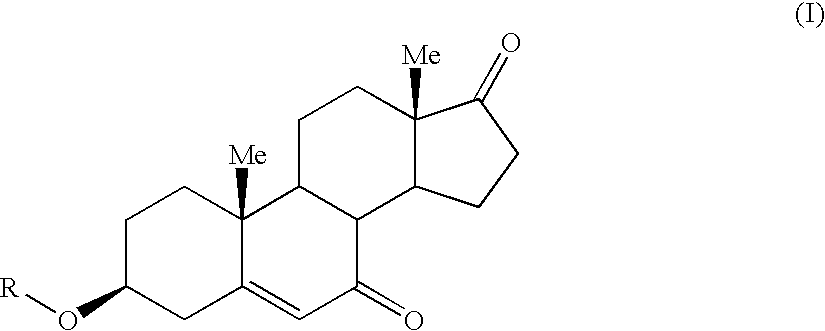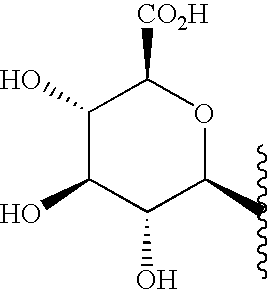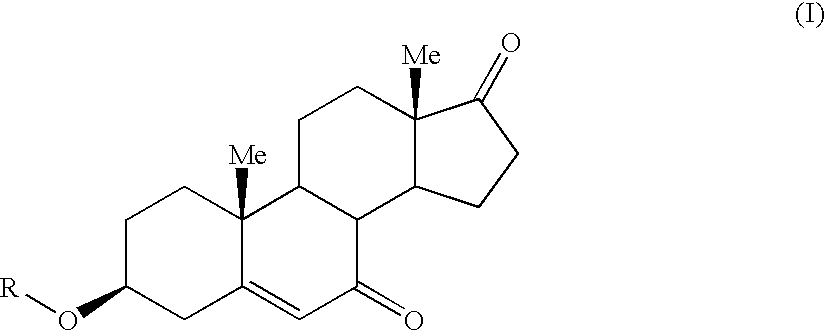7-Oxo-DHEA compounds for treating keratinous conditions/afflictions
a technology of keratinous conditions and compounds, applied in the field of7oxodhea derivatives, can solve the problems of difficult hormonal effects of dhea, and achieve the effect of improving the appearance of keratinous substrates/materials
- Summary
- Abstract
- Description
- Claims
- Application Information
AI Technical Summary
Benefits of technology
Problems solved by technology
Method used
Image
Examples
example 1
This example describes a variety of specific compositions according to the invention.
Composition 1; Moisturizing Cream:Phase A:Acrylate / C10-30 acrylate copolymer0.5%Water12.0% Phase B:Hydrogenated polyisobutene5.0%3β-O-7-oxo-DHEA α-glutamate0.5%Cyclohexasiloxane6.0%Phase C:Triethanolamine1.0%Glycerol6.0%EDTA0.2%Preservatives0.5%Glycine2.0%Polyacrylamide and C13-14 isoparaffin and laureth-71.0%Waterqs 100%
This composition was prepared in the following manner. The polymer of phase A was dispersed in water at 40° C. The constituents of phase B were heated to 70° C. until completely dissolved, and the temperature was then reduced to 40° C. The constituents of phase C were mixed together at 50° C. Phase B was then introduced into phase A at 40° C. with stirring, and phase C was then added thereto.
The above composition rehydrates dry skin and renders it smooth.
Composition 2; Moisturizing Cream:The composition below was formulated in conventional manner.Phase A:Demineralized waterqs 100% ...
example 2
Synthesis of 3β-O-acetyl-7-oxo-DHEA
A solution of 10 g of 3β-O-acetyl-DHEA in 200 ml of acetonitrile was prepared. 60 mg of copper iodide (CuI) were added thereto under an inert atmosphere. The solution was cooled to between 5° and 10° C. and 19.6 ml of 80% t-BuOOH were added dropwise. At the end of the addition, the reaction medium was allowed to return to room temperature and was stirred for 2 hours, followed by heating at 50° C. for 20 hours. The reaction medium was then cooled and poured into 300 g of 10% sodium bicarbonate (NaHCO3) solution. This mixture was extracted three times with diethyl ether and the organic solution was then washed with saturated NaHCO3 solution, and then with saturated sodium chloride (NaCl) solution. After drying and evaporating to dryness, the crude product was obtained in the form of a solid. The residue was recrystallized from an acetone / hexane mixture.(a) Melting point: 190-192° C.;(b) Yield: 91%;(c) [α]d=−76° (methanol);(d) 1H NMR and mass spectro...
example 3
Synthesis of 7-oxo-DHEA
A solution of 3β-O-acetyl-7-oxo-DHEA obtained in Example 2 in methanol was prepared. 1 molar equivalent of sodium methoxide (NaOMe) was added and the mixture was stirred for a period of between 3 and 12 hours. The methanol was evaporated off and the residue was diluted with water and extracted with dichloromethane. The organic solution was dried and then evaporated to dryness. The residue was purified by chromatography to give the 7-oxo-DHEA.
PUM
| Property | Measurement | Unit |
|---|---|---|
| weight loss | aaaaa | aaaaa |
Abstract
Description
Claims
Application Information
 Login to View More
Login to View More - R&D
- Intellectual Property
- Life Sciences
- Materials
- Tech Scout
- Unparalleled Data Quality
- Higher Quality Content
- 60% Fewer Hallucinations
Browse by: Latest US Patents, China's latest patents, Technical Efficacy Thesaurus, Application Domain, Technology Topic, Popular Technical Reports.
© 2025 PatSnap. All rights reserved.Legal|Privacy policy|Modern Slavery Act Transparency Statement|Sitemap|About US| Contact US: help@patsnap.com



